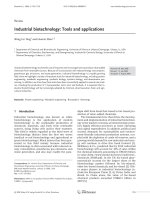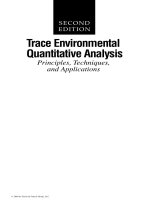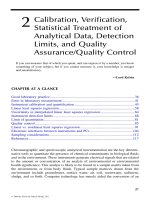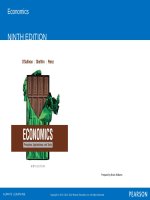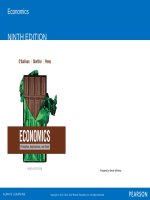Economics principles tools and applications 9th by sullivan sheffrin perez chapter 24
Bạn đang xem bản rút gọn của tài liệu. Xem và tải ngay bản đầy đủ của tài liệu tại đây (936.2 KB, 38 trang )
Economics
NINTH EDITION
Chapter 24
Perfect Competition
Copyright © 2015, 2012, 2009 Pearson Education, Inc. All Rights Reserved
Learning Objectives
24.1 Distinguish between four market structures.
24.2 Explain the short-run output rule and the break-even price.
24.3 Explain the shut-down rule.
24.4 Explain why the short-run supply curve is positively sloped.
24.5 Explain why the long-run industry supply curve may be positively sloped.
24.6 Describe the short-run and long-run effects of changes in demand for an increasing-cost industry.
24.7 Describe the short-run and long-run effects of changes in demand for a constant-cost industry.
Copyright © 2015, 2012, 2009 Pearson Education, Inc. All Rights Reserved
Perfect Competition (1 of 2)
•
Perfectly competitive market
A market with many sellers and buyers of a homogeneous product and no barriers to entry.
•
Price taker
A buyer or seller that takes the market price as given.
Copyright © 2015, 2012, 2009 Pearson Education, Inc. All Rights Reserved
Perfect Competition (2 of 2)
Here are the five features of a perfectly competitive market:
1.
There are many sellers.
2.
There are many buyers.
3.
The product is homogeneous.
4.
There are no barriers to market entry.
5.
Both buyers and sellers are price takers.
Copyright © 2015, 2012, 2009 Pearson Education, Inc. All Rights Reserved
24.1 PREVIEW OF THE FOUR
MARKET STRUCTURES (1 of 3)
Firm-specific demand curve
A curve showing the relationship between the price charged by a specific firm and the quantity the firm can sell.
Copyright © 2015, 2012, 2009 Pearson Education, Inc. All Rights Reserved
24.1 PREVIEW OF THE FOUR
MARKET STRUCTURES (2 of 3)
In Panel A, the demand curve facing a monopolist is the market
demand curve.
In Panel B, a perfectly competitive firm takes the market price as
given, so the firm-specific demand curve is horizontal. The firm can
sell all it wants at the market price, but would sell nothing if it charged
a higher price.
Copyright © 2015, 2012, 2009 Pearson Education, Inc. All Rights Reserved
24.1 PREVIEW OF THE FOUR
MARKET STRUCTURES (3 of 3)
TABLE 24.1 Characteristics of the Four market Structures
Characteristics
Perfect Competition
Monopolistic
Oligopoly
Monopoly
Competition
Number of firms
Many
Many
Few
One
Type of product
Homogeneous
Differentiated
Homogeneous or differentiated
Unique
Firm-specific
Demand is perfectly
Demand is elastic but not
Demand is less elastic than
Firm faces market demand
Demand curve
Elastic
perfectly elastic
demand facing monopolistically
curve
competitive firm
Entry conditions
Examples
No barriers
Corn, plain T-shirts
No barriers
Large barriers from economies
Large barriers from economies
of scale or government policies
of scale or government policies
Toothbrushes, music stores,
Air travel, automobiles,
Local phone service, patented
groceries
beverages, cigarettes, mobile
drugs
phone service
Copyright © 2015, 2012, 2009 Pearson Education, Inc. All Rights Reserved
APPLICATION 1
WIRELESS WOMEN IN PAKISTAN
APPLYING THE CONCEPTS #1: How do entry costs affect the number of firms in a market?
In Pakistan, phone service is now provided by thousands of “wireless women,” entrepreneurs who invest $310 in wireless phone equipment (transceiver, battery,
charger), a signboard, a calculator, and a stopwatch.
They sell phone service to their neighbors, charging by the minute and second.
On average, their net income is about $2 per day, about three times the average per capita income in Pakistan.
The market for phone service has the features of a perfectly competitive market, with easy entry, a standardized good, and a large enough number of suppliers
that each takes the market price as given.
In contrast, to enter the phone business in the United States, your initial investment would be millions, or perhaps billions, of dollars, so the market for phone
service is not perfectly competitive.
Copyright © 2015, 2012, 2009 Pearson Education, Inc. All Rights Reserved
24.2 THE FIRM’S SHORT-RUN OUTPUT DECISION (1 of 5)
The Total Approach: Computing Total Revenue and Total Cost
TABLE 24.2 Deciding How Much to Produce When the Price Is $12
1
Output:
Shirts per
Minute (Q)
2
3
Fixed
Variable
Cost (FC)
Cost (VC)
4
Total
Cost (TC)
5
6
7
Total
Profit =
Marginal
Revenue
TR –TC
Revenue =
(TR)
Price
8
Marginal
Cost
(MC)
0
$17
$0
$ 17
$0
-$17
1
17
5
22
12
-10
$12
$5
2
17
6
23
24
1
12
1
3
17
9
26
36
10
12
3
4
17
13
30
48
18
12
4
5
17
18
35
60
25
12
5
6
17
25
42
72
30
12
7
7
17
34
51
84
33
12
9
8
17
46
63
96
33
12
12
9
17
62
79
108
29
12
16
10
17
83
100
120
20
12
21
Copyright © 2015, 2012, 2009 Pearson Education, Inc. All Rights Reserved
24.2 THE FIRM’S SHORT-RUN OUTPUT DECISION (2 of 5)
The Total Approach: Computing Total Revenue
and Total Cost
Economic profit is shown by the vertical distance between the totalrevenue curve and the total-cost curve.
To maximize profit, the firm chooses the quantity of output that generates
the largest vertical difference between the two curves.
Copyright © 2015, 2012, 2009 Pearson Education, Inc. All Rights Reserved
24.2 THE FIRM’S SHORT-RUN OUTPUT DECISION (3 of 5)
The Marginal Approach
MARGINAL PRINCIPLE
Increase the level of an activity as long as its marginal benefit exceeds its marginal cost. Choose the level at which the marginal benefit equals the
marginal cost.
Marginal revenue
The change in total revenue from selling one more unit of output.
Marginal revenue = price
To maximize profit, produce the quantity where price = marginal cost
Copyright © 2015, 2012, 2009 Pearson Education, Inc. All Rights Reserved
24.2 THE FIRM’S SHORT-RUN OUTPUT DECISION (4 of 5)
The Marginal Approach
A perfectly competitive firm takes the market price as given, so the
marginal benefit, or marginal revenue, equals the price.
Using the marginal principle, the typical firm will maximize profit at
point a, where the $12 market price equals the marginal cost.
Economic profit equals the difference between the price and the
average cost ($4.125 = $12 – $7.875) times the quantity produced
(eight shirts per minute), or $33 per minute.
Copyright © 2015, 2012, 2009 Pearson Education, Inc. All Rights Reserved
24.2 THE FIRM’S SHORT-RUN OUTPUT DECISION (5 of 5)
Economic Profit and the Break-Even Price
economic profit = (price − average cost) × quantity produced
Break-even price
The price at which economic profit is zero; price equals average total cost.
Copyright © 2015, 2012, 2009 Pearson Education, Inc. All Rights Reserved
APPLICATION 2
THE BREAK-EVEN PRICE FOR SWITCHGRASS, A FEEDSTOCK FOR BIOFUEL
APPLYING THE CONCEPTS #2: What is the break-even price?
To illustrate the notions of break-even price, let’s look at these prices for the typical farmer.
Comparing switchgrass to alfalfa:
The implicit rent on land to grow alfalfa $120 per acre.
If the switchgrass yield is 3 tons per acre, the opportunity cost is $40 per ton.
If the explicit cost of a ton of switchgrass is $36
The breakeven price is $76 = $36 + $40
To get some farmers to grow switchgrass instead of alfalfa the price must be at least $56 per ton and to get the most fertile land switched the price must be $95 per ton,
or $76 on average.
Copyright © 2015, 2012, 2009 Pearson Education, Inc. All Rights Reserved
24.3 THE FIRM’S SHUT-DOWN DECISION
(1 of 4)
TABLE 24.3 Deciding How Much to Produce When the Price Is $4
1
2
3
4
5
6
7
8
Output: Shirts per
Fixed Cost (FC)
Variable Cost (VC)
Total Cost (TC)
Total Revenue (TR)
Profit = TR – TC
Marginal Revenue =
Marginal Cost (MC
Minute (Q)
Price
0
$17
$0
$ 17
$0
-$ 17
1
17
5
22
4
-18
$4
$5
2
17
6
23
8
-15
4
1
-14
4
3
Total Revenue,
Variable
Cost, and
the Shut-Down
Decision
3
17
9
26
12
4
17
13
Operate
30 if total revenue >
16variable cost
-14
4
4
5
17
18
Shut down
35 if total revenue <
20variable cost
-15
4
5
Copyright © 2015, 2012, 2009 Pearson Education, Inc. All Rights Reserved
24.3 THE FIRM’S SHUT-DOWN DECISION
(2 of 4)
Total Revenue, Variable Cost, and the Shut-Down
Decision
When the price is $4, marginal revenue equals marginal cost at four
shirts (point a).
At this quantity, average cost is $7.50, so the firm loses $3.50 on
each shirt, for a total loss of $14.
Total revenue is $16 and the variable cost is only $13, so the firm is
better off operating at a loss rather than shutting down and losing its
fixed cost of $17.
The shutdown price, shown by the minimum point of the AVC curve,
is $3.00.
Copyright © 2015, 2012, 2009 Pearson Education, Inc. All Rights Reserved
24.3 THE FIRM’S SHUT-DOWN DECISION
(3 of 4)
The Shut-Down Price
Operate if price > average variable cost
Shut down if price < average variable cost
Shut-down price
The price at which the firm is indifferent between operating and shutting down; equal to the minimum average variable cost.
Copyright © 2015, 2012, 2009 Pearson Education, Inc. All Rights Reserved
24.3 THE FIRM’S SHUT-DOWN DECISION
(4 of 4)
Fixed Costs and Sunk Costs
Sunk cost
A cost that a firm has already paid or committed to pay, so it cannot be recovered.
Copyright © 2015, 2012, 2009 Pearson Education, Inc. All Rights Reserved
APPLICATION 3
STRADDLING THE ZINK COST CURVE
APPLYING THE CONCEPTS #3: What is the shut down price?
Zinc is a vital input to the production of steel. Because the cost of mining zinc varies from one mine to another, the shutdown price varies too. The world price of
zinc decreased from roughly $2,300 per ton in 2010-2011 to $1,900 in early 2012.
The lower price was below the shutdown prices of Alcoa’s mines in Italy and Spain: at a price of $1,900, the total revenue from the mines was less than the
variable cost of operating the mines.
The shutdown of Alcoa’s mines decreased mining output by 531,000 tons. Although mines with lower production costs continued mining at a price of $1,900,
many mines have shutdown prices in the range $1,500 to $1,900, and will shut down if the price continues to drop.
Copyright © 2015, 2012, 2009 Pearson Education, Inc. All Rights Reserved
24.4 SHORT-RUN SUPPLY CURVES (1 of 4)
The Firm’s Short-Run Supply Curve
Short-run supply curve
A curve showing the relationship between the market price of a product and the quantity of output supplied by a firm in the short run.
Copyright © 2015, 2012, 2009 Pearson Education, Inc. All Rights Reserved
24.4 SHORT-RUN SUPPLY CURVES (2 of 4)
The Firm’s Short-Run Supply Curve
In Panel A, the firm’s short-run supply curve is the part of the marginalcost curve above the shut-down price.
In Panel B, there are 100 firms in the market, so the market supply at a
given price is 100 times the quantity supplied by the typical firm. At a
price of $7, each firm supplies 6 shirts per minute (point b), so the
market supply is 600 shirts per minute (point f)
Copyright © 2015, 2012, 2009 Pearson Education, Inc. All Rights Reserved
24.4 SHORT-RUN SUPPLY CURVES (3 of 4)
The Short-Run Market Supply Curve
Short-run market supply curve
A curve showing the relationship between market price and the quantity supplied in the short run.
Copyright © 2015, 2012, 2009 Pearson Education, Inc. All Rights Reserved
24.4 SHORT-RUN SUPPLY CURVES (4 of 4)
Market Equilibrium
In Panel A, the market demand curve intersects the short-run
market supply curve at a price of $7.
In Panel B, given the market price of $7, the typical firm satisfies
the marginal principle at point b, producing six shirts per minute.
The $7 price equals the average cost at the equilibrium quantity,
so economic profit is zero, and no other firms will enter the
market.
Copyright © 2015, 2012, 2009 Pearson Education, Inc. All Rights Reserved
APPLICATION 4
THE SHORT RUN SUPPLY CURVE FOR CARGO
APPLYING THE CONCEPTS #4: Why is the short-run supply curve positively sloped?
Consider the supply of shipping services. The law of supply suggests that as the price of shipping increases, the quantity of shipping services will increase. The
figure below shows the supply curve for shipping services.
At a relatively low freight rate of $2 per ton, only the most efficient ships operate, and they economize on fuel by traveling at a slow speed. As a result, the
annual quantity of shipping services is relatively low (70 units per year).
At an intermediate freight price of $3 per ton, more ships are engaged: less efficient ships join the fleet. In addition, all the ships travel at a greater speed, using
more fuel in the process. The combination of more ships and faster travel increases the quantity of shipping services provided (85 units per year).
At a high freight rate of $7 per ton, all the ships operate and run at full speed, and the quantity of shipping services is 96 units per year.
Copyright © 2015, 2012, 2009 Pearson Education, Inc. All Rights Reserved
24.5 THE LONG-RUN SUPPLY CURVE FOR AN INCREASING-COST
INDUSTRY (1 of 5)
Long-run market supply curve
A curve showing the relationship between the market price and quantity supplied in the long run.
Increasing-cost industry
An industry in which the average cost of production increases as the total output of the industry increases; the long-run supply curve is
positively sloped.
Copyright © 2015, 2012, 2009 Pearson Education, Inc. All Rights Reserved
